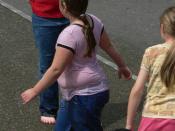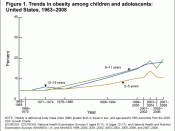Nine-year-old Katy lives in an apartment with her divorced mother on a busy street. While Katy's mother, Peggy, is working full time, Katy comes home from school and immediately sits on the couch to eat chocolate chip cookies because she does not have a yard to play in. Only two times a week does Katy get physical education at school. Peggy tries to teach her daughter about the importance of nutrition, but she simply has no time to set an example for her. Over the next few years, Peggy notices that children's sizes no longer fit Katy and she finds herself buying clothes that would fit a fifteen to sixteen-year-old.
Like Katy, many children are finding themselves becoming obese. According to Leonard Epstein and Sally Squires, in America ten to thirty percent of eight to eighteen year olds are obese; in addition, one in every five children aged six to eleven is obese (13).
Obesity occurs when an individual eats more calories than his or her body uses causing fat accumulation and weight gain. Medical problems such as diabetes, hypertension, hyperlipidemia, and atherosclerosis that were once common to overweight adults are now being found in obese children (Levick 89). The dramatic increase in childhood obesity over the past few years is due to changes in diet, a lack of physical activity, lower socioeconomic status, and even genetics.
Children consuming high-calorie foods is a major factor to children being obese. Instead of choosing to eat an apple between physical activities, children sit on the couch to watch television while eating handfuls of potato chips. "Foods with higher fat are easier to access as many families tend to eat out or eat on the run, often eating foods in larger portions with a higher caloric intake," says Samuel Gidding, pediatric cardiologist at...



HAHA
The first paragraph is very dramatic, it sounds like one of those CCF advertisements. It is good, captures my attention and interest. Good range of credible sources cited as well. Well done!
4 out of 7 people found this comment useful.